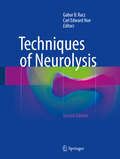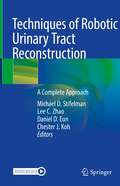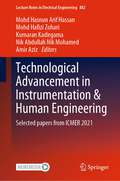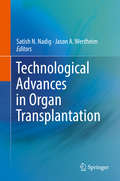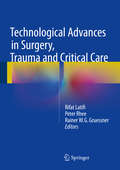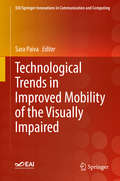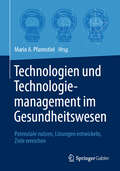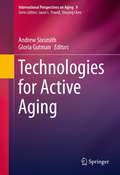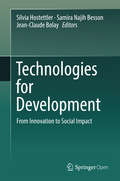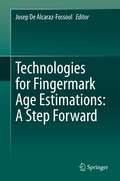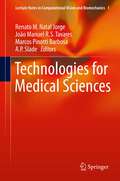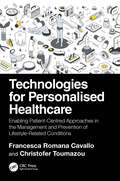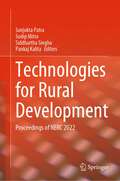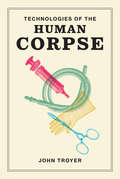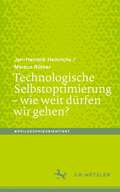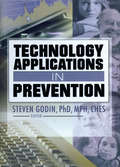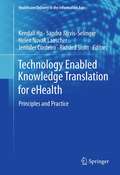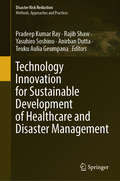- Table View
- List View
Techniques of Neurolysis
by Gabor B. Racz Carl Edward NoeWritten and edited by the foremost practitioners of neurolysis, this completely revised and updated second edition assembles the current methods of neurolytic procedures into a single volume. The book explains in great detail trigeminal and radiofrequency techniques, facet joint denervation, cryoneurolysis and lumbosacral, thoracic and cervial neuroplasty. The new concept of the scarring triangle and treatment that may prevent surgical failures is proposed. Neuroaugmentation and complimentary procedures are also covered. Indications, contraindications, and complications of these treatments are discussed along with outcomes on some of the case studies featured in the first edition. Interventional pain physicians, as well as palliative pain physicians, neurosurgeons, and orthopedic spine surgeons, will find this text to be the definitive reference on neurolysis in clinical practice.
Techniques of Robotic Urinary Tract Reconstruction: A Complete Approach
by Michael D. Stifelman Lee C. Zhao Daniel D. Eun Chester J. KohThis book provides a complete and thorough guide to the performance of robotic urinary tract reconstruction procedures, including the principals of successful reconstructive techniques in the kidney, ureter, bladder, prostate and urethra. Reviewing patient positioning, trocar placement, instrumentation, detailed steps of procedure, and available outcome data, it outlines both common and advanced techniques, such as revision of uretero-intestinal anastomoses, buccal mucosa graft for long segment ureteral strictures, management of complex fistulas and urethral stricture. Illuminating unusual anatomy, including horseshoe kidney, retrocaval ureter, ureteral duplication, ectopic/malrotated kidneys, and retroperitoneal fibrosis, this book also highlights potential complications, their avoidance and management. Written by experts in the field, Techniques of Robotic Urinary Tract Reconstruction: A Complete Approach guides clinical practitioners in the utilization of advanced novel technology to aid intraoperation and demonstrates the ways in which robotics enables the performance of reconstructive procedures in an area difficult to reach via open techniques.
Technische Biochemie: Die Biochemie und industrielle Nutzung von Naturstoffen
by Oliver Kayser Nils J. AvereschDieses Lehrbuch der Biochemie wurde für die 2. Auflage vollständig überarbeitet und erweitert. Biotechnologen und Bioverfahrenstechniker finden präzise Informationen zu modernen Fragestellungen in dem faszinierenden und komplexen Gebiet der Technischen Biochemie, denn Technik und Biologie muss kein Widerspruch sein. Die Autoren haben den Versuch gewagt, ein Lehrbuch für Studierende der Bioingenieurwissenschaften auch aus dem Blickwinkel der Studierenden zu sehen und zu schreiben. Im Gegensatz zu bekannten und sehr gut etablierten Lehrbüchern der Biologie, Biochemie und Biotechnologie werden hier biologische Konzepte vorgestellt und mit technischen wie ingenieurwissenschaftlichen Problemen verknüpft. Das Anliegen dieses Lehrbuches ist, biochemische Prinzipien in der Naturstoffbiosynthese zu beleuchten und ihre biotechnischen und bioverfahrenstechnischen Herstellungswege zu erklären. Inhalt Anwendung der Biochemie in der Medizin, Pharmazie und Technik Photosynthese − die Chemie des Lichts Stoffwechsel der Kohlenhydrate − Zucker als Energieträger Aminosäuren und Peptide − Proteine als Biokatalysatoren Kohlenhydrate, Lipide und Proteine − Grundbausteine für technische und pharmazeutische Stoffe Wichtige Biosynthesen des Primär- und Sekundärstoffwechsels Naturstoffbiosynthese − Biologie und Chemie sekundärer Metabolite Zielgruppen Studierende der Bioverfahrenstechnik, Biotechnologie, Pharmazie, Chemie Biologen, Biotechniker, Verfahrenstechniker, Pharmazeuten, Chemiker mit Schwerpunkt Biotechnologie
Technological Advancement in Instrumentation & Human Engineering: Selected papers from ICMER 2021 (Lecture Notes in Electrical Engineering #882)
by Mohd Hasnun Arif Hassan Mohd Hafizi Zohari Kumaran Kadirgama Nik Abdullah Nik Mohamed Amir AzizThis book (Technological Advancement in Instrumentation & Human Engineering) gathers selected papers submitted to the 6th International Conference on Mechanical Engineering Research in fields related to human engineering, ergonomics, vibration, instrumentation, Internet of Things and signal processing. This proceeding consists of papers in aforementioned related fields presented by researchers and scientists from universities, research institutes and industry showcasing their latest findings and discussions with an emphasis on innovations and developments in embracing the new norm, resulting from the COVID pandemic.
Technological Advances in Care of Patients with Kidney Diseases
by Subodh J. Saggi Moro O. SalifuThe book explores how kidney disease care is being changed by new technologies, from inception and diagnosis to dialysis and kidney transplant. Massive technological advances have affected health care in the past decade, and doctors are moving quickly to change the way we provide care for kidney diseases. We are rapidly shifting from hospital- and clinic-based systems to providing care at home, with technologies that help monitor care and intervene remotely. Some of the technologies covered include genetic testing for diagnostic and therapeutic purposes, metabolism/ezposome assessment, AI-driven tool for drug dosing, and apps available to patients. This book aims to educate providers on the many new scientific and technological interventions that can help monitor and mitigate kidney disease.
Technological Advances in Organ Transplantation
by Satish N. Nadig Jason A. WertheimThis book provides an expert view into the current technologies that are revolutionizing the field of solid organ transplantation. This unique book provides insight into progress made in areas spanning robotic surgery to tissue engineering and also gives a glimpse into what may lie ahead for this innovative specialty. Topics covered include nanotherapy, machine perfusion, artificial organ development, robotics in transplant surgery, mobile health technology, stem cell therapy, and ex vivo repair of organs. This is an ideal book for biomedical engineers, physicians and surgeons, general and transplant surgeons, medical students, medical and surgical trainees, and transplant procurement technicians.
Technological Advances in Surgery, Trauma and Critical Care
by Rifat Latifi Peter Rhee Rainer W.G. GruessnerThis text is designed to provide a comprehensive and state-of-the-art overview of the major issues specific to technological advances the field trauma, critical care and many aspects of surgical science and practice. Care of these patients and clinical conditions can be quite complex, and materials have been collected from the most current, evidence-based resources. The sections of the text have been structured to review the overall scope of issues dealing with trauma, critical care and surgery, including cardiothoracic surgery, vascular surgery, urology, gynecology and obstetrics, fetal surgery and orthopedics. This volume represents the most comprehensive textbook covering a wide range of topics and technological advances including genomics and nanotechnologies that affect patients' care and surgeons' practice daily. The multidisciplinary authorship includes experts from all aspects of trauma, surgery and critical care. The volume highlights the dramatic changes in the field including hand held devices and smart phones used in daily medical and surgical practice, complex computers in the critical care units around the world, and robotics performing complex surgical procedures and tissue engineering. Technological Advances in Surgery, Trauma and Critical Care provides a comprehensive, state-of-the art review of this field, and will serve as a valuable resource for clinicians, surgeons and researchers with an interest in trauma, critical care, and all the specialties of surgery. It provides a concise yet comprehensive summary of the current status of the field that will help guide patient management and stimulate investigative efforts.
Technological Innovations for Managing Tropical Diseases (Health Information Science)
by Sylvester Chibueze Izah Matthew Chidozie OgwuTropical diseases continue to impose a significant burden on global health, particularly in low- and middle-income regions. These diseases challenge healthcare systems, exacerbate economic disparities, and threaten global public health. In this rapidly evolving landscape, integrating advanced technologies offers unprecedented opportunities to transform the prevention, diagnosis, monitoring, and treatment of tropical diseases. This groundbreaking volume explores biosensor advancements, wearable technologies, artificial intelligence, predictive modeling, mobile health, and biotechnological innovations. Each chapter delves into how these cutting-edge solutions address the unique challenges of tropical diseases, from improving diagnostics and disease surveillance to enabling equitable access to care in resource-limited settings. The book also examines the ethical, technical, and economic barriers to implementation, providing actionable strategies to overcome these challenges. Key features include: In-depth analysis of innovative diagnostic tools, including biosensors and IoT-enabled wearables. Insights into AI and machine learning applications for outbreak prediction and resource allocation. Case studies of mobile health, telemedicine, and robotics in tropical disease management. Exploration of biotechnological and therapeutic advances tailored to tropical diseases. Critical analysis of ethical considerations, data security, and equitable technology access. A forward-looking perspective on emerging trends and their alignment with global health goals. Aligned with the United Nations Sustainable Development Goals (SDGs), this book emphasizes the role of technology in achieving SDG 3 (Good Health and Well-being) and SDG 9 (Industry, Innovation, and Infrastructure). It is an indispensable resource for public health professionals, researchers, policymakers, bioengineers, healthcare technologists, and academics seeking to address the complexities of tropical diseases with innovative, sustainable solutions. This is a transformative guide to leveraging technology for a healthier, more resilient world.
Technological Trends in Improved Mobility of the Visually Impaired (EAI/Springer Innovations in Communication and Computing)
by Sara PaivaThis book provides an insight into recent technological trends and innovations in mobility solutions and platforms to improve mobility of visually impaired people. The authors' goal is to help to contribute to the social and societal inclusion of the visually impaired. The book’s topics include, but are not limited to, obstacle detection systems, indoor and outdoor navigation, transportation sustainability systems, and hardware/devices to aid visually impaired people. The book has a strong focus on practical applications, tested in a real environment. Applications include city halls, municipalities, and companies that can keep up to date with recent trends in platforms, methodologies and technologies to promote urban mobility. Also discussed are broader realms including education, health, electronics, tourism, and transportation. Contributors include a variety of researchers and practitioners around the world.Features practical, tested applications of technological mobility solutions for visual impaired people;Presents topics such as obstacle detection systems, urban mobility, smart home services, and ambient assisted living;Includes a number of application examples in education, health, electronics, tourism, and transportation.
Technologiegestützte Ansätze in der Community-basierten Prävention und Gesundheitsförderung
by Florian Fischer Kamil J. WronaIn einer Epoche, in der die Digitalisierung fast alle Lebensbereiche durchdringt, entstehen auch im Kontext der technologiegestützten Prävention und Gesundheitsförderung neue Chancen und Herausforderungen. Aktuell dominieren verhaltensorientierte Maßnahmen, während die Integration von Technologien in soziale Kontexte (Communities) zwar vielversprechend ist, aber noch unzureichend genutzt wird. Dieses Buch schlägt eine Brücke zwischen sozio-technischen Innovationen und praktischer Anwendung innerhalb der Gesellschaft. Es zeigt Anforderungen für Fachpersonen, Personen mit Entscheidungsbefugnissen und Interessierte auf und lädt dazu ein, sich intensiv mit den Potenzialen und Herausforderungen digital-unterstützter Prävention und Gesundheitsförderung auseinanderzusetzen. Es wird betont, dass technologische Ansätze nicht isoliert von der jeweiligen Community und den in ihr lebenden Individuen betrachtet werden können. Sie sind eingebettet in soziokulturelle Dynamiken und Normen, die ihr Potenzial sowohl erweitern als auch begrenzen können. Themen wie Zugang zur digitalen Gesundheitsvorsorge, Validität und Sicherheit von Gesundheitsdaten sowie die Anpassungsfähigkeit von Technologien an soziale und kulturelle Kontexte werden interdisziplinär anhand konkreter Beispiele aus verschiedenen Lebensphasen und -umwelten beleuchtet. Der Sammelband richtet sich an jene, die an der Schnittstelle von Technologie, Gesundheit und Sozialem tätig sind.
Technologien und Technologiemanagement im Gesundheitswesen: Potenziale nutzen, Lösungen entwickeln, Ziele erreichen
by Mario A. PfannstielTechnologien tragen erheblich zur Verbesserung der Patientenversorgung im Gesundheitswesen bei. Um das in ihnen liegende Potenzial zu heben und sicherzustellen, dass die richtigen Technologien zum Einsatz kommen, ist eine umfassende Herangehensweise notwendig. Diese beginnt mit einer gründlichen Analyse und Bewertung der verfügbaren Technologien für den jeweiligen Einsatzbereich. Das Technologiemanagement übernimmt im Anschluss die Schlüsselrolle bei der effizienten Einführung neuer Technologien, einschließlich strukturierter Implementierung, Kostenkontrolle und der Gewährleistung von Sicherheit und Datenschutz. Auf diese Weise wird sichergestellt, dass Technologien reibungslos in bestehende Strukturen integriert werden, die Effizienz im Gesundheitswesen steigt und die Qualität der Patientenversorgung erheblich verbessert wird. Das vorliegende Herausgeberwerk gibt einen Überblick zu den aktuellen Themen aus Theorie und Praxis des Technologiemanagements im Gesundheitswesen und umfasst auch Fragen zum Einsatz von künstlicher Intelligenz. In 44 Beiträgen teilen 92 renommierte Autoren ihre umfangreiche Expertise, wertvollen Erkenntnisse, Erfahrungen und vielfältigen Perspektiven und geben konkrete Hinweise für die Praxis. Das Buch zeichnet sich durch eine klare Strukturierung und Einordnung der Buchbeiträge in den technologischen Gesamtkontext aus, wodurch es gleichermaßen für Einsteiger als auch für Praktiker und Wissenschaftler von großem Nutzen ist.
Technologies for Active Aging
by Andrew Sixsmith Gloria GutmanThe challenge of population aging requires innovative approaches to meet the needs of increasing numbers of older people. Emerging information and communication technologies (ICTs), such as pervasive computing and ambient assistive technology, have considerable potential for enhancing the quality of life of many older people by providing additional safety and security while also supporting mobility, independent living, and social participation. The proposed book will be a landmark publication in the area of technology and aging that will serve as a statement of the current state-of-the-art and as a pointer to directions for future research and emerging technologies, products, and services.
Technologies for Development: From Innovation to Social Impact
by Jean-Claude Bolay Silvia Hostettler Samira Najih BessonThis open access book presents 18 case studies that explore current scientific and technological efforts to address global development issues, such as poverty, from a holistic and interdisciplinary point of view, putting actual impacts at the centre of its analysis. It illustrates the use of technologies for development in various fields of research, such as humanitarian action, medical and information and communication technology, disaster risk-reduction technologies, habitat and sustainable access to energy. The authors discuss how innovative technologies, such as unmanned aerial vehicles for disaster risk reduction, crowdsourcing humanitarian data, online education and ICT-based medical technologies can have significant social impact. The book brings together the best papers of the 2016 International Conference on Technologies for Development at EPFL, Switzerland. The book explores how the gap between innovation in the global South and actual social impact can be bridged. It fosters exchange between engineers, other scientists, practitioners and policy makers active at the interface of innovation and technology and human, social, and economic development.
Technologies for Fingermark Age Estimations: A Step Forward
by Josep De Alcaraz-FossoulThis book discusses new applications of technologies that have been or could be successfully employed to estimate the age of fingermarks. Determining the specific time a fingermark is deposited could become a powerful new development in forensic science and a useful application to law enforcement. This book aims to shed some light on this important and still controversial area of scientific research. The expert chapters review recent discoveries and current developments with a practical bent, focusing on prospective uses in real-world crime scenes. They take a multidisciplinary approach, featuring contributors with diverse specialties including Chemistry, Imaging Technologies, Forensic Science, Biology and Microbiology. The balanced presentation incorporates critiques on fingermark aging studies, explores the reliability of fingermarks as evidence, and discusses how the estimation of “age” can improve robustness of crime evidence. Each chapter describes a unique aspect of fingermark aging observed from a different analytical perspective: 2D imaging; 3D imaging; chemical analysis; chemical imaging; microbiome analysis; electrochemical analysis; and DNA analysis, as well as the role and application of statistics. Illustrations and graphs aid the reader in understanding the concepts being explained. Not just a compilation of techniques and methods, this book’s emphasis on practical applications and its easy-to-read style will appeal to a broad audience of scientists and criminal justice professionals alike. It will be of great interest to law enforcement, academia, and the criminal justice community; including forensic scientists, investigators, lawyers, students, and researchers. It aims to help facilitate debates in the broader community about the feasibility, convenience, and relevance of estimating the age of evidence.
Technologies for Medical Sciences
by A. P. Slade Joao Tavares Marcos Pinotti Barbosa Renato M. Natal JorgeThis book presents novel and advanced technologies for medical sciences in order to solidify knowledge in the related fields and define their key stakeholders. The fifteen papers included in this book were written by invited experts of international stature and address important technologies for medical sciences, including: computational modeling and simulation, image processing and analysis, medical imaging, human motion and posture, tissue engineering, design and development medical devices, and mechanic biology. Different applications are treated in such diverse fields as biomechanical studies, prosthesis and orthosis, medical diagnosis, sport, and virtual reality. This book is of interest to researchers, students and manufacturers from a wide range of disciplines related to bioengineering, biomechanics, computational mechanics, computational vision, human motion, mathematics, medical devices, medical image, medicine and physics.
Technologies for Personalised Healthcare: Enabling Patient-Centred Approaches in the Management and Prevention of Lifestyle-Related Conditions
by Francesca Romana Cavallo Christofer ToumazouThis book explores how personalised healthcare can be realised with the integration of new and established technologies, and how novel methods can be developed to improve health outcomes in lifestyle-related conditions. Technologies for Personalised Healthcare: Enabling Patient-Centred Approaches in the Management and Prevention of Lifestyle-Related Conditions explores various aspects of personalised healthcare in the context of lifestyle-related conditions— from how statistics and machine learning can be used to extrapolate clinically useful stratifications from big data, to how adaptive AI can enable behaviour change; from how biosensors and point-of-care devices can bring diagnostics closer to the patient, to the ethical aspects of personalised medicine. The highly multidisciplinary nature of the book gives the reader a broad view of established and emerging technologies for personalised healthcare. It provides the technical background underpinning these technologies, while case studies present practical applications of the methods discussed. The content and worked examples found within this book can serve as a reference guide on the technologies and methods needed to tap into the endless opportunities to be realised within personalised healthcare. This book is intended for researchers and academics who want to know more about how they can apply computational methods and electronics within the field of personalised healthcare. It is also for those who are interested in the bridge between technology, engineering, and medicine.It is our hope that this book will serve as a catalyst for further innovation and collaboration in the pursuit of personalised healthcare solutions.
Technologies for Rural Development: Proceedings of NERC 2022
by Pankaj Kalita Sanjukta Patra Sudip Mitra Siddhartha SinghaThe book spans across the research domains of mechanisation and automation, agrobusiness, food processing and value addition, climate smart agriculture, rural sanitation, agro biotechnology, and rural energy.
Technologies of Life and Death: From Cloning to Capital Punishment
by Kelly OliverThe central aim of this book is to approach contemporary problems raised by technologies of life and death as ethical issues that call for a more nuanced approach than mainstream philosophy can provide. To do so, it draws on the recently published seminars of Jacques Derrida to analyze the extremes of birth and dying insofar as they are mediated by technologies of life and death. With an eye to reproductive technologies, it shows how a deconstructive approach can change the very terms of contemporary debates over technologies of life and death, from cloning to surrogate motherhood to capital punishment, particularly insofar as most current discussions assume some notion of a liberal individual.The ethical stakes in these debates are never far from political concerns such as enfranchisement, citizenship, oppression, racism, sexism, and the public policies that normalize them. Technologies of Life and Death thus provides pointers for rethinking dominant philosophical and popular assumptions about nature and nurture,chance and necessity, masculine and feminine, human and animal, and what it means to be a mother or a father. In part, the book seeks to disarticulate a tension between ethics and politics that runs through these issues in order to suggest a more ethical politics by turning the force of sovereign violence back against itself. In the end, it proposes that deconstructive ethics with a psychoanalytic supplement can provide a corrective for moral codes and political clichés that turn us into mere answering machines.
Technologies of Procreation: Kinship in the Age of Assisted Conception
by Sarah Franklin Marilyn Strathern Jeanette Edwards Eric Hirsch Frances PriceTechnologies of Procreation bridges the gap between medical technology and cultural values. It looks at the ways in which the 'technologies of procreation' affect society from an anthropological perspective.
Technologies of the Human Corpse (The\mit Press Ser.)
by John TroyerThe relationship of the dead body with technology through history, from nineteenth-century embalming machines to the death-prevention technologies of today.Death and the dead body have never been more alive in the public imagination—not least because of current debates over modern medical technology that is deployed, it seems, expressly to keep human bodies from dying, blurring the boundary between alive and dead. In this book, John Troyer examines the relationship of the dead body with technology, both material and conceptual: the physical machines, political concepts, and sovereign institutions that humans use to classify, organize, repurpose, and transform the human corpse. Doing so, he asks readers to think about death, dying, and dead bodies in radically different ways. Troyer explains, for example, how technologies of the nineteenth century including embalming and photography, created our image of a dead body as quasi-atemporal, existing outside biological limits formerly enforced by decomposition. He describes the “Happy Death Movement” of the 1970s; the politics of HIV/AIDS corpse and the productive potential of the dead body; the provocations of the Body Worlds exhibits and their use of preserved dead bodies; the black market in human body parts; and the transformation of historic technologies of the human corpse into “death prevention technologies.” The consequences of total control over death and the dead body, Troyer argues, are not liberation but the abandonment of Homo sapiens as a concept and a species. In this unique work, Troyer forces us to consider the increasing overlap between politics, dying, and the dead body in both general and specifically personal terms.
Technologies to Enable Autonomous Detection for BioWatch
by Institute of Medicine National Research Council Board on Health Sciences Policy Board on Life Sciences Joe Alper Sheena M. Posey Norris India Hook-BarnardThe BioWatch program, funded and overseen by the Department of Homeland Security (DHS), has three main elements--sampling, analysis, and response--each coordinated by different agencies. The Environmental Protection Agency maintains the sampling component, the sensors that collect airborne particles. The Centers for Disease Control and Prevention coordinates analysis and laboratory testing of the samples, though testing is actually carried out in state and local public health laboratories. Local jurisdictions are responsible for the public health response to positive findings. The Federal Bureau of Investigation is designated as the lead agency for the law enforcement response if a bioterrorism event is detected. In 2003 DHS deployed the first generation of BioWatch air samplers. The current version of this technology, referred to as Generation 2.0, requires daily manual collection and testing of air filters from each monitor. DHS has also considered newer automated technologies (Generation 2.5 and Generation 3.0) which have the potential to produce results more quickly, at a lower cost, and for a greater number of threat agents. Technologies to Enable Autonomous Detection for BioWatch is the summary of a workshop hosted jointly by the Institute of Medicine and the National Research Council in June 2013 to explore alternative cost-effective systems that would meet the requirements for a BioWatch Generation 3.0 autonomous detection system, or autonomous detector, for aerosolized agents . The workshop discussions and presentations focused on examination of the use of four classes of technologies--nucleic acid signatures, protein signatures, genomic sequencing, and mass spectrometry--that could reach Technology Readiness Level (TRL) 6-plus in which the technology has been validated and is ready to be tested in a relevant environment over three different tiers of temporal timeframes: those technologies that could be TRL 6-plus ready as part of an integrated system by 2016, those that are likely to be ready in the period 2016 to 2020, and those are not likely to be ready until after 2020. Technologies to Enable Autonomous Detection for BioWatch discusses the history of the BioWatch program, the role of public health officials and laboratorians in the interpretation of BioWatch data and the information that is needed from a system for effective decision making, and the current state of the art of four families of technology for the BioWatch program. This report explores how the technologies discussed might be strategically combined or deployed to optimize their contributions to an effective environmental detection capability.
Technologische Selbstoptimierung – wie weit dürfen wir gehen? (#philosophieorientiert)
by Jan-Hendrik Heinrichs Markus RütherTechnologische Selbstoptimierung ist gegenwärtig in aller Munde. Sie umfasst die Erforschung neuer Möglichkeiten im Hinblick auf Schönheitsoperationen, funktionale Implantologie, Gehirndoping oder die Verlängerung der Lebensspanne. Gegenüber vielen dieser technischen Mittel, die oft nicht legal verfügbar sind, bestehen erhebliche gesellschaftliche Vorbehalte. Jan-Hendrik Heinrichs und Markus Rüther plädieren bei ihrer ethischen Einschätzung für eine Differenzierung der Perspektive: Die Vorbehalte sind nämlich ihrer Meinung nach nicht geeignet, gesellschaftliche Ächtung oder gar verbindliche Verbote für alle zu begründen. Vielmehr habe die Freiheit zur Selbstgestaltung Vorrang, was jedoch nicht heißt, dass es für manche Bereiche nicht auch klare Regeln geben muss. Weil Selbstgestaltung aber nur frei sein kann, wenn sie informiert ist, argumentieren die Autoren für Regelungen, die von weitgehenden Informationspflichten statt von Verboten bestimmt sind. Aus einer individuellen Sicht heraus lassen sich zudem eine Reihe von moralischen Empfehlungen formulieren, die zwar nicht eingefordert werden können, aber einen ethischen Kompass bilden, um sich im Dickicht der ethischen Debatte an guten Gründen zu orientieren.
Technology Applications in Prevention
by Steven GodinControl health care costs with these cost-effective, technology-based prevention/intervention techniques!In 2001, Americans spent $1.4 trillion on health care services. By 2010, health care costs are forecasted to approach 20% of the United States&’ Gross National Product. Technology Applications in Prevention highlights much-needed technology-based prevention/intervention methods that can help contain health costs. "Efficient and Effective Uses of Technology in Community Research" provides the information that future prevention researchers and program evaluators will need to be effective in electronic data collection, management, and cost analysis. "Community Building with Technology: The Development of Collaborative Community Technology Initiatives" presents a case example showing how Web sites can function as regional clearinghouses of useful information and provide convenient forums where agency staff can update their prevention skills. "Applying Web-Based Survey Design Standards" addresses a question critical to professionals in e-data collection: How reliable is Web-based needs assessment and/or outcome data? This chapter suggests standards that should be adhered to in Internet-based data collection. "Assessing Quality Assurance of Self-Help Sites on the Internet" and "The Quality of Spanish Health Information Web Sites: An Emerging Disparity" address the current lack of quality in the health and mental health information available on the World Wide Web. "A Participatory Internet Initiative in an African-American Neighborhood" explores health disparity concerns regarding the use of the Internet. This chapter discusses several ways to empower those who are on the dark side of the "digital divide"-and shows how to ensure that Web-based material is culturally relevant and appropriate for those it is intended to help. "Alcohol Abuse Prevention Among High-Risk Youth" presents a case example of a life-skills based CD-ROM intervention designed to discourage kids from abusing alcohol. "Constructing Better Futures Via Video" looks at video-based futures planning, which combines self-modeling and "feedforward" to forecast a student&’s future capabilities. This technique helps teenagers find meaning in their current educational setting and prepare for adulthood. This chapter also explains how to train school-based personnel to encourage positive attitudes and support the life skills of their students via carefully planned and edited-yet inexpensive-video productions.Why is the information in this book so essential? In 2000, approximately 20% of U.S. employers changed their health insurance plans as a cost savings strategy. American companies and their employees must new deal with new insurance plans that have reduced the breadth of their coverage and/or increased employee deductibles. The need for cost-effective preventive strategies is becoming increasingly more urgent as employers and insurance companies scramble to provide affordable health care coverage. New technologies have opened the door to better, more economical modes of preventive care. This book presents a vital cross-section of the current state of the art in the application of technology to prevention and intervention. Make it a part of your professional/teaching collection today!
Technology Enabled Knowledge Translation for eHealth
by Sandra Jarvis-Selinger Helen Novak Lauscher Richard Scott Jennifer Cordeiro Kendall HoRapid progress in health research has led to generation of new knowledge and innovative practices in management of illness. This has resulted in a significant challenge for health professionals: if today we discovered a new therapy through research, when will this discovery be regularly prescribed or utilized to treat all patients suffering from this condition? Knowledge translation is the non-linear and often complicated process of translating knowledge into routine health practices. Technology enabled knowledge translation (TEKT) is the use of information and communication technologies (ICT) to accelerate knowledge translation. With the ubiquity of the internet, the proliferation of different approaches in communication and social networking, and the continuously improving technologies from netbooks to smartphones, there are rich opportunities for TEKT in health education, service delivery, and research.
Technology Innovation for Sustainable Development of Healthcare and Disaster Management (Disaster Risk Reduction)
by Anirban Dutta Rajib Shaw Pradeep Kumar Ray Yasuhiro Soshino Teuku Aulia GeumpanaThis book provides holistic case studies of technology development, examples of its complexities and an in-depth analysis from the perspective of information infrastructure. Natural disasters such as cyclones, tsunamis, earthquakes and volcanoes have disrupted the lives of people all over the world, particularly in Asia. In order to manage disasters and mitigate the damage, many technologies—surveillance systems, for instance—have been developed. An example of natural disaster is the ongoing devastation caused by COVID-19, which highlights the multi-disciplinary nature of disaster management, including agriculture, healthcare, economics, environment, engineering and technology. The pandemic has also led to the development and uptake of technologies such as vaccine development, new biotechnological innovations, telemedicine, the Internet of things (IoT) and mobile health (mHealth) all over the world. The United Nations Sustainable Development Goals (SDGs) programme suggests an integrated approach to their development. For example, healthcare needs to be addressed in holistic perspectives including education, environment, economy and regulations, among others. These goals create challenges in the development, validation and deployment of new technology, with this book presenting a discussion of innovations in sustainable development of healthcare in the multi-disciplinary context of SDGs.
